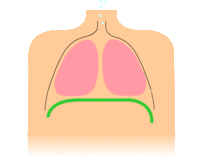- Diaphragmatic breathing
-
Diaphragmatic breathing, abdominal breathing, belly breathing or deep breathing is breathing that is done by contracting the diaphragm, a muscle located horizontally between the chest cavity and stomach cavity. Air enters the lungs and the belly expands during this type of breathing.
This deep breathing is marked by expansion of the abdomen rather than the chest when breathing. It is considered by some to be a healthier and fuller way to ingest oxygen[1], and is sometimes used as a therapy for hyperventilation, anxiety disorders and stuttering.
Contents
How it is done
According the National Center for Complementary and Alternative Medicine, "12.7 percent of American adults [have] used deep-breathing exercises... for health purposes,"[2] which it describes as follows, "Deep breathing involves slow and deep inhalation through the nose, usually to a count of 10, followed by slow and complete exhalation for a similar count. The process may be repeated 5 to 10 times, several times a day."[3]
To breathe diaphragmatically, or with the diaphragm, one must draw air into the lungs in a way which will expand the stomach and not the chest. It is best to perform these breaths as long, slow intakes of air – allowing the body to absorb all of the inhaled oxygen while simultaneously relaxing the breather.[medical citation needed]
To do this comfortably, it is often best to loosen tight-fitting pants/belts/skirts (nude also works well), as these can interfere with the body's ability to intake air. While at first one may not feel comfortable expanding the stomach during breathing, diaphragmatic breathing actually fills up the majority of the lungs with oxygen – much more than chest-breathing or shallow breathing.[medical citation needed]
A sample exercise
A common[citation needed] diaphragmatic breathing exercise is as follows:
- Sit or lie comfortably, with loose garments.
- Put one hand on your chest and one on your stomach.
- Slowly inhale through your nose or through pursed lips (to slow down the intake of breath).
- As you inhale, push your belly/ stomach out and feel your stomach expand with your hand.
- Slowly exhale through pursed lips to regulate the release of air while squeezing your belly/ tummy.
- Rest and repeat.
Benefits
Deep breathing exercises are a form of relaxation, and therefore, when practiced regularly, lead to the relief or prevention of symptoms commonly associated with stress, which may include high blood pressure, headaches, stomach conditions, depression, anxiety, and others.[4]
Performing diaphragmatic breathing can be therapeutic, and with enough practice, can become a standard way of breathing.[medical citation needed]
Some breath therapists and breathing teachers[by whom?] believe that because of the stress of modern life in many people,[who?] along with bad posture and a lack of awareness of the sensations associated with the movement of the diaphragm during proper breathing, which makes it difficult for the diaphragm to move freely through its full range of motion.
There are other, distinct diaphragmatic breathing exercises taught by CAM practitioners.[5]
Stuttering/Stammering
A form of diaphragmatic breathing (often referred to as costal breathing) is taught by several therapy programmes including the Starfish Project and the McGuire Programme as a method of treating stuttering.
How it happens
The term 'diaphragmatic' is sometimes misinterpreted to imply that the thoracic diaphragm is not used in shallow breathing. This is a misunderstanding as the diaphragm is used in either case. In belly breathing, the lower ribs are stabilized and the central tendon of the diaphragm is mobilized so that a contraction of the diaphragm pulls the tendon down. In rib cage breathing, the central tendon is stabilized and the lower ribs are mobilized so that a contraction lifts the lower ribs.[medical citation needed]
Due to the lung expansion being lower (inferior) on the body as opposed to higher up (superior), it is referred to as 'deep' and the higher lung expansion of rib cage breathing is referred to as 'shallow'. The actual volume of air taken into the lungs with either means varies. Attaining maximal lung expansion may require both diaphragmatic contraction as well as rib cage expansion, as the amount of room created by the abdominal depression or rib stretching may not create an adequate enough vacuum space on their own.
Relation to Yoga and meditation
Some[which?] yoga and meditation traditions draw a clear distinction between diaphragmatic breathing and abdominal breathing or belly breathing. The more specific technique of diaphragmatic breathing is said to be more beneficial.
When the diaphragm is dysfunctional
For some, the diaphragm is dysfunctional[medical citation needed], in which case one should focus on slow inhalation and exhalation (through the nose and pursed lips).
See also
- Breath
- Shallow breathing - a type of breathing that is mutually exclusive to diaphragmatic breathing and is associated with multiple anxiety disorders
- Circular breathing
- Pranayama - a traditional Yogic practice of slowing and extending the breaths, used during meditation
- Kussmaul breathing
External Links
References
- ^ "Breathe properly to improve speaking skills.". http://www.greatvoice.com/speaker/vc_library/voicemastery.html.
- ^ "Relaxation Techniques for Health: An Introduction" http://nccam.nih.gov/health/stress/relaxation.htm
- ^ http://nccam.nih.gov/health/providers/camterms.htm "Terms Related to Complementary and Alternative Medicine"
- ^ "To relax using this method, you consciously slow your breathing and focus on taking regular and deep breaths...Because relaxation is the opposite of stress, the theory is that voluntarily creating the relaxation response through regular use of relaxation techniques could counteract the negative effects of stress...Chronic stress may lead to high blood pressure, headaches, stomach ache, and other symptoms. Stress may worsen certain conditions, such as asthma. Stress also has been linked to depression, anxiety, and other mental illnesses." - Relaxation Techniques for Health: An Introduction
- ^ Breathing exercises
External links
CAM therapy suggestions
Categories:
Wikimedia Foundation. 2010.

